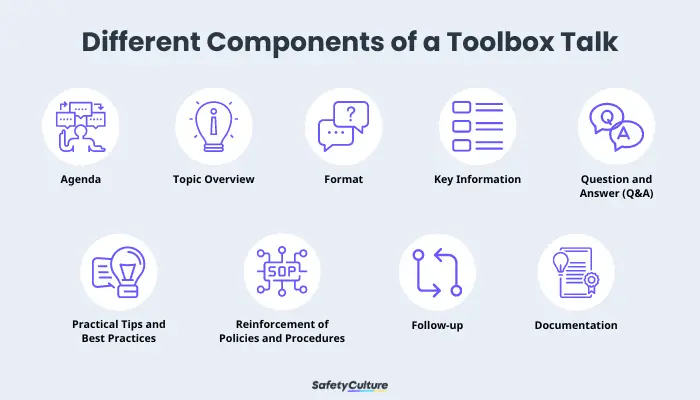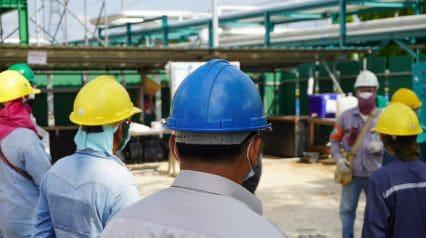What are Toolbox Talk Examples?
Toolbox talk examples are industry- or job-specific topics that can be used to guide organizations in creating effective toolbox talks. These aim to promote awareness, discuss safety-related issues, practices, and procedures, educate employees, reinforce safe work habits, and mitigate risks and hazards in the workplace.
Why Use Practical Examples During Toolbox Talks
To help toolbox talk participants get a better understanding of safety protocols before commencing work, using practical examples during the session can be helpful to achieve the following advantages:
- Real-life Relevance – By using examples that align with their specific tasks, equipment, or work environment, employees can better understand how the safety principles discussed directly relate to their own work situations.
- Improved Understanding – Practical examples help clarify complex safety concepts by providing tangible and relatable scenarios.
- Engaged Participation – Practical examples enable employees to be more engaged, ask questions, and share their own experiences or insights related to those examples.
- Behavioral Change – When employees see how specific actions or decisions can lead to positive outcomes or potential hazards, they are more motivated to adopt safe practices and make better choices in their work activities.
- Application of Learning – By understanding how safety principles can be implemented in practical scenarios, employees are more likely to incorporate these practices into their work habits, resulting in a safer work environment.
- Continuous Improvement – Practical examples provide a platform for discussion and learning from past incidents or near misses.
Components of a Toolbox Talk

Different Components of a Toolbox Talk
Like all effective safety toolbox talk examples, a good one consists of key points and sections. To ensure a well-structured, informative, and engaging toolbox talk, consider incorporating the following components when conducting one:
- Agenda – Outline the agenda and set expectations for the session to help participants understand the structure of the talk and what will be covered.
- Topic Overview – Explain why the specific safety topic is relevant to the workplace and its potential risks or hazards.
- Format – Let participants know the toolbox talk’s format and how they can actively engage during the talk.
- Key Information – Present the key points and essential information related to the topic that employees need to be aware of and follow.
- Question and Answer (Q&A) – Allow time for an open floor discussion to address any concerns, share their experiences, or clarify any aspects of the topic.
- Practical Tips and Best Practices – Share specific examples or techniques that employees can implement in their work to enhance safety.
- Reinforcement of Policies and Procedures – Emphasize the importance of adhering to these policies to ensure a safe working environment.
- Follow-up – Discuss any follow-up actions or additional resources that will be provided after the toolbox talk.
- Documentation – Keep a record of the toolbox talk topics covered, the date, participants, and any notes or feedback to serve as evidence of the safety training conducted in the workplace.
Improve your EHS Management
Cultivate a safe working environment and streamline compliance with our EHS solutions.
Explore nowDifferent Toolbox Talk Formats
Toolbox talks can be done in various ways, depending on the job, industry, or needs of the organization. Also, using different formats can help you cater to various learning preferences and enhance the effectiveness of the toolbox talk.
The following are some of the most common formats to consider:
- Informal Chat – The supervisor or safety officer engages in a casual conversation with the workers, addressing the safety topic in a relaxed and interactive manner.
- Safety Briefing – This follows a concise and structured format where the supervisor or safety officer delivers a brief presentation on the safety topic.
- Online App or Software – These platforms offer interactive modules, quizzes, and resources that workers can access on their smartphones, tablets, or computers.
- Presentation – In this format, the supervisor or safety officer utilizes visual aids such as slides or PowerPoint presentations to deliver information on the safety topic.
- Demonstration – The supervisor or safety officer physically demonstrates safety procedures or the correct use of safety equipment.
- Video – Pre-recorded safety videos or online resources can be shown to workers, highlighting best practices, potential hazards, and preventive measures.
- Other Materials – These can include manuals, handouts, pamphlets, posters, interactive worksheets, or case studies that provide additional information or reinforce key safety messages.
Create Your Own Toolbox Talk Checklist
Eliminate manual tasks and streamline your operations.
Get started for FREEToolbox Talk Examples
Here are some practical examples of how toolbox talks are conducted in various industries:
Toolbox Talk Example for Construction
Topic: Preventing Falls from Heights
Introduction: As we know, working at heights poses significant risks, but by following proper procedures and using the right equipment, we can prevent accidents and injuries.
Key Points:
- Recognize the hazards.
- Use fall protection equipment.
- Set up safe access and work platforms.
- Maintain good housekeeping.
- Ensure the proper use of ladders.
- Communicate and report hazards.
Conclusion: In the construction industry, preventing falls from heights is our collective responsibility. By remembering and practicing these key points, we can reduce the risk of falls on our construction site. Let’s stay vigilant, look out for each other’s safety, and make every effort to prevent falls from heights
Toolbox Talk Example for Hospitality
Topic: Preventing Slips, Trips, and Falls
Introduction: In our line of work, we encounter various hazards that can lead to accidents and injuries. By being proactive and implementing proper safety measures, we can create a safer environment for ourselves and our guests.
Key Points:
- Keep walkways clear.
- Wear appropriate footwear.
- Regularly inspect and maintain floors.
- Use handrails.
- Use proper lifting techniques.
- Ensure that all areas, including corridors, stairways, and parking lots, are well-lit.
- Be aware of wet or slippery surfaces.
- Report and address hazards.
Conclusion: By implementing these key points, we can significantly reduce the risk of accidents in the hospitality industry. Let’s stay vigilant, communicate effectively, and work together to create a safe and welcoming environment for everyone.
Toolbox Talk Example for Manufacturing
Topic: Machine Safety and Hazard Awareness
Introduction: As we work with various machines and equipment, it’s crucial to understand the potential hazards involved and take proactive measures to prevent accidents and injuries.
Key Points:
- Understand machine hazards.
- Ensure that all machines are properly guarded with safety devices.
- Follow lockout tagout (LOTO) procedures when servicing or performing maintenance on machines.
- Wear appropriate Personal Protective Equipment (PPE).
- Follow proper operating procedures for each machine.
- Keep work areas clean and free from clutter.
- Report hazards and near misses.
Conclusion: Machine safety and hazard awareness are essential in the manufacturing industry to protect ourselves and our coworkers. By understanding and observing these key points, we can surely reduce the risk of accidents and injuries.
Toolbox Talk Example for Retail
Topic: Fire Safety and Emergency Preparedness
Introduction: As retail professionals, it’s our responsibility to be prepared for potential fire emergencies and know how to respond effectively to protect lives and property. By understanding fire prevention measures, implementing safety protocols, and conducting regular drills, we can create a safe environment for everyone.
Key Points:
- Keep all areas of the store clean and free from clutter, ensuring proper storage and disposal of flammable materials.
- Familiarize yourself with the location and proper use of fire extinguishers in the store.
- Be aware of the store’s evacuation procedures and escape routes.
- Ensure that emergency contact information is prominently displayed and easily accessible.
- Participate in fire safety training sessions and drills conducted by the store management.
- Be proactive in reporting potential fire hazards to the appropriate personnel.
Conclusion: Ensuring fire safety and being prepared for emergencies are essential responsibilities in the retail industry. By following these crucial safety protocols, we can create a safe environment for employees and customers alike.
Toolbox Talk Example for Transport and Logistics
Topic: Defensive Driving and Road Safety
Introduction: As drivers, we face various risks on the road, and it’s crucial to prioritize safety by observing defensive driving techniques and following road rules and regulations.
Key Points:
- Practice defensive driving by anticipating potential hazards and being prepared to react appropriately.
- Always wear your seat belt and ensure that all passengers in the vehicle are properly restrained.
- Observe and follow posted speed limits at all times.
- Regularly inspect and maintain your vehicle.
- Be aware of blind spots when driving larger vehicles or when towing trailers.
- Maintain composure and patience while driving.
- Avoid distracted driving.
- Adhere to traffic signals and signs.
- Avoid driving while fatigued.
- Report and address safety concerns.
Conclusion: Defensive driving and road safety are essential in the transport and logistics industry to protect ourselves, our passengers, and other road users. By practicing these among other safety measures, we can significantly reduce the risk of accidents and injuries.
Toolbox Talk Example for Facilities Management
Topic: Electrical Safety
Introduction: As professionals responsible for the maintenance and operation of various facilities, we often encounter electrical systems and equipment that pose potential risks. Hence, we must understand the hazards associated with electricity and follow proper safety practices to prevent accidents, injuries, and damage to property.
Key Points:
- Be aware of the potential risks associated with electricity.
- Regularly inspect electrical systems and report any abnormalities to the appropriate personnel.
- Only use electrical equipment that is in good condition and suitable for the intended purpose.
- Understand and follow LOTO procedures when performing maintenance checks or repairs on electrical systems or equipment.
- Use appropriate PPE when working with or near electrical systems or equipment.
- Stay updated on electrical safety practices through regular training sessions and educational resources.
Conclusion: By prioritizing electrical safety in our facilities management practices, we can minimize the risk of accidents and create a safer work environment for everyone. Remember to stay vigilant, report any electrical hazards, and follow proper procedures when working with or near electrical systems and equipment.




